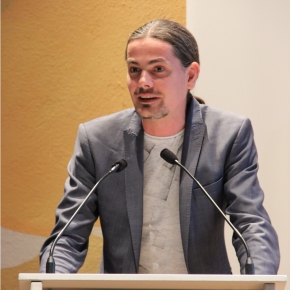Emmanuel Hugot
Biography
Emmanuel Hugot is a French astrophysicist, expert in innovative instrumentation, today leading one of the three science teams at the Laboratory for Astrophysics of Marseille, the Research and Development Group. His interests in this field are broad, from the manufacturing of super-polished freeform optics for cutting-edge instrumentation, to the development of a new type of focal planes using variable curvature detectors, thus leading to compact and cost-effective instrumentation, crucial for the post-JWST generation such as the LUVOIR observatory currently under study at NASA.
For ten years now, he is leading cutting edge R&D projects for high angular resolution and high contrast imaging, based on the synergies between active and adaptive optics, materials science and innovative focal plane architectures. His work has also a multi-disciplinary impact, as it involves imaging science that finds applications in many fields, from bio-medical science to artistic projects.
Some of his hand-made mirrors are today at the core of the most powerful astronomical instruments, such as the VLT-SPHERE planet finder, seeking for exoplanets every night. He has been awarded the young researcher prize in 2014, delivered by the French association of professional astronomers.
Project : Innovative Compact Architectures for Research and Universe Sensing (ICARUS) : Towards Cost-effective astronomical instrumentation
Enabling disruptive technologies has always been crucial to trigger revolutionary science discoveries. The daring challenges in astronomy and astrophysics are extremely demanding in terms of high angular resolution and high contrast imaging, and require extreme stability and image quality. Instruments based on current classical designs tend to get bigger and more complex, and are faced to ever increasing difficulties to meet science requirements.
This 5-years project proposes breakthrough compact optical architectures for the next generation of giant observatories. The project focus on the niche of active components and is structured in two main research pillars to :
- Enable the use of additive manufacturing (3D-printing) to produce affordable deformable mirrors for VIS or NIR observations,
- Pave the road for a common use of curved and deformable detectors.
To maximize the impact of this high gain R&D, the program is surrounded by two transverse activities :
- design and optimization of a new zoo of optical systems using active mirrors and flexible detectors
- build a solid plan of technology transfer to end-user industrial companies, through a patenting and licensing strategy, to maximize the financial return and then perpetuate the activities.
The pathway proposed is mandatory to develop affordable components in the near future, and will enable compact and high performance instrumentation. These high potential activities will dramatically reduce the complexity of instruments in the era of giant observatories, simplify the operability of systems and offer increased performances.
Laboratory
Laboratory for astrophysics of Marseille - LAM : CNRS / Université Aix Marseille.
